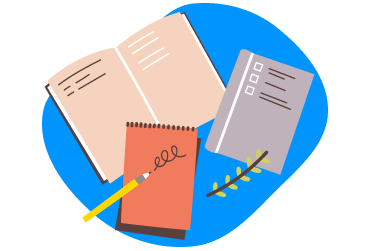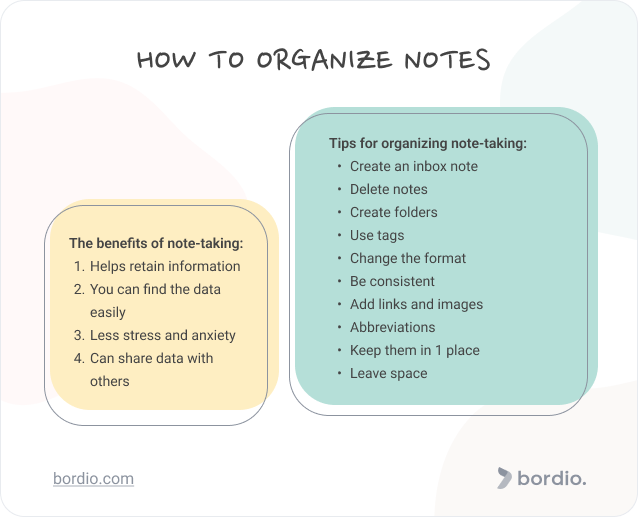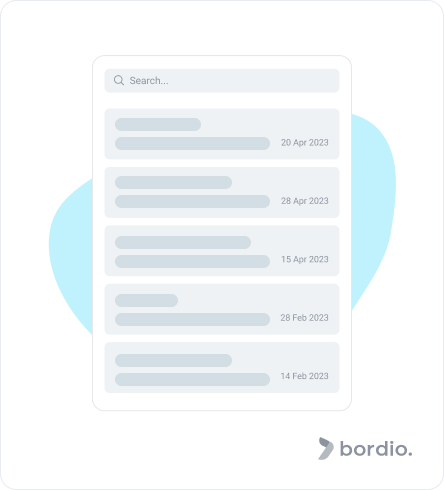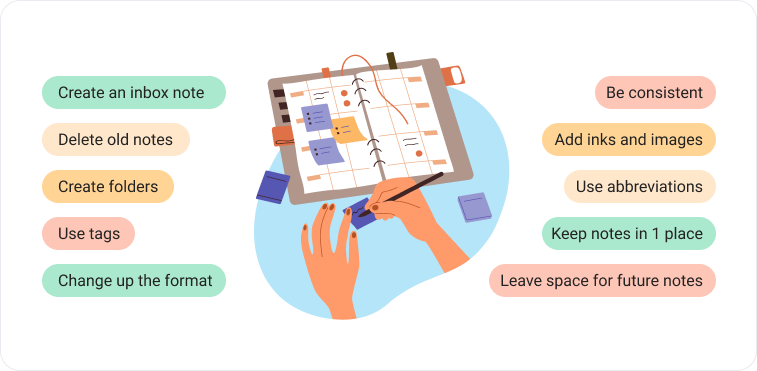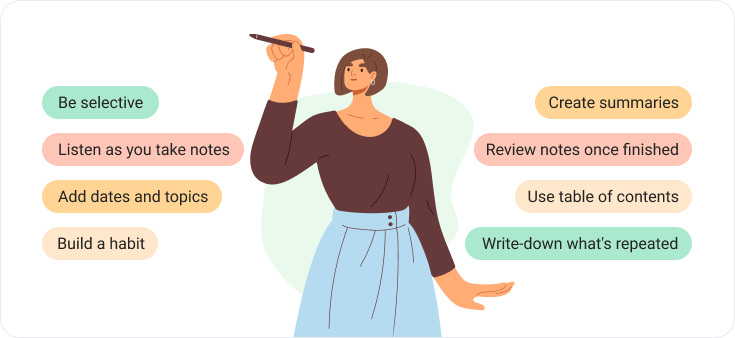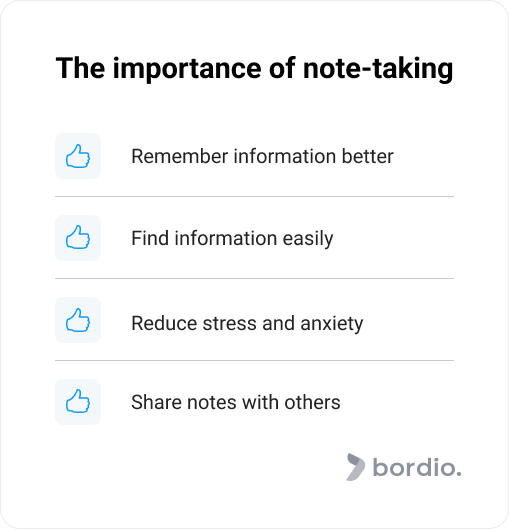Note-taking, paper records or in the task tracker online, is a wonderful practice that helps us remember more, stay organized, and be on top of all our tasks and projects.
Without a structure, though, notes go out of control very quickly, creating a huge mess that is harder to navigate than a labyrinth.
Organizing notes is tricky if you’ve never done it before, but we are here to help! Our tips and recommendations will help you sort out existing notes and develop a habit of making structured, clear notes in the future, both hand-written and digital.
For more organizational tips, make sure to read about Organizing Your Gmail, Google Drive, and Bookmarks.
The struggle of digital note-taking and note organization
Before technology became a part of our daily lives, taking notes was reserved for pen and paper only. And while it was easy to create a mess of your paper notes then, once we switched to digital note-taking apps – the crisis escalated quickly.
When it takes literal seconds to make a note, and you can write them anywhere (special app, messenger, or calendar), the number of notes and their contents goes out of control.
Get yourself Bordio – a powerful note-taking and planning app
Taking notes is easy, using them is a whole different story.
A note-taking app influences your process much more than you think.
A good app will guide you and empower you to organize notes faster and easier. It will remove obstacles and needless settings to help you focus on what’s really important.
Bordio is a weekly planner with a smart notes section. Not only do you store data and produce notes, but you actually enjoy working with them and can find whatever piece of information you need via a systemized structure.
Write meeting notes in free schedule maker and create separate notes for each individual project, helping users stay organized and in control of what is written where.
Take better notes with Bordio.
Tips for organizing notes efficiently
If even the thought of writing notes properly gives you headaches – worry not! Read the list of tips below and implement them in your daily process. You will soon see a dramatic improvement in your workflow.
#1 Inbox
Create an inbox of some kind to write down everything without losing it. Treat your inbox as a single storage for all your miscellaneous notes. Set a deadline for when your inbox has to be sorted out.
Remember that you don’t have to follow the Inbox Zero approach (when your inbox must be completely empty), but it’s a good idea to work on decreasing the number of notes in the inbox. After all, you create notes to work with them, and having everything dumped into a single place is counterproductive.
As you introduce this practice, pay special attention to how well you’re sorting the inbox out. For example, create events in Bordio’s online calendar planner with a 30-minute to 1-hour time block to go through all notes in the inbox and allocate them to other folders.
Bonus tip: It’s okay if some notes live in your inbox forever, for example, notes that you review in the schedule builder online daily. Just make sure you keep the number of such notes low because most of the time the things we deem necessary in the inbox could easily be moved somewhere else.
#2 Delete notes
Do you delete notes often? We bet you still have 6-year-old notes on your phone about something that has not been relevant since 2020.
Digital hoarding is a rising issue, and keeping absolutely all of your typed notes all the time is contributing to the problem.
So if you feel that you are struggling with the idea of deleting notes, try this exercise:
- Go through your notes.
- Identify notes that weren’t used or checked for over a year (make it 2 or 3 if you’ve been taking notes for multiple years already).
- Delete at least one note the first time you do this exercise.
- Repeat again next week and double the number of notes you deleted.
- Practice until you get comfortable with deleting notes.
Important: Use common sense. If you really only have notes that you need, and they’re all relevant and can be used in the near future, – don’t delete them. Just stay open to the idea of digital decluttering.
Sorting out notes is an important part of organizing your life but it shouldn’t become an obsession just for the sake of it. Implement it in your note-taking system slowly and see where it takes you.
#3 Create folders to organize notes
Creating folders can be a lifesaver for everyone, not just vigorous note-takers.
Folders help systemize all notes and reduce the time you waste searching for information. They complement each note-taking method, whether you prefer physical notes in the bullet journal, visual notes, or simple digital notes. Check and organize things in schedule maker weekly.
The main rule with folders is that you create them the way that serves you. Check what everyone else is doing, but go with the structure and naming that make sense in your individual situation. You will be the one working with notes, so do your best to make folders convenient for you.
#4 Use tags when organizing notes
Tags are little helpers that allow you to navigate notes easily.
Depending on what you work with, you might have a special section for adding tags in your notes, or you can simply write keywords within the note and search using those keywords later.
For example, if you like reading and making notes on books, use keywords such as sci-fi, non-fiction, or best books to segment your notes. Later, when you’ll be looking for something specific, you’ll be able to put those keywords in the search field and save yourself some time.
Bonus tip: Don’t overdo it with tags. Having too many is almost as bad as having none because you’ll likely forget half of them. If you are the person with too many tags, go through them and remove duplicates or tags that you’ve barely used.
#5 Change up the format
You don’t have to solely write notes by hand or type them on your computer/smartphone.
If you are in a situation where typing is an issue but something has to be written down (say, if you hold your kid in one hand, and have the dog’s leash in the other hand) – use speech-to-write functionality. It is supported by most smartphones, but it won’t work in every note app. Check if yours does, and speak, when writing down is not an option.
Another option is to record information with audio or video. This method is good for meetings or interviews. Just make sure you notify everyone in the room that you will be recording to avoid legal issues and just to be polite in general.
Overall, try various note-taking methods and apply them in different life situations.
#6 Be consistent with notes organization
It’s great to change up the format of note-taking from typing on your phone to audio, but it’s not good if you constantly change your written notes’ format.
Notes are instruments, and you shouldn’t complicate things too much for yourself. Stick to the same format, such as starting with the date and topic, keeping the summary on top, and the main body of the note below.
#7 Add images and links
Your notes are a working tool. Maximize its efficiency by adding images and links to additional materials straight in notes. You can use templates to streamline your note-taking process. After this, your notes will become a more efficient working tool. Anything that’s related to the body of the note should be logged in the note. Next time you need to use it, you won’t have to look elsewhere for more data.
#8 Use abbreviations
Abbreviations, or shorthands, are great time savers. Try things like “bc” instead of because and shorten words, for example, “man-t” instead of management.
#9 Organize your notes in one place
Avoid spreading your notes across countless apps and notepads. If you must, keep one paper notepad and one digital daily planner. If your notes are all over the place, you will forget you have some of them, and you’ll be wasting precious time trying to find them. We recommend using Bordio’s best online planner.
#10 Leave space for future notes
As you review the notes you’ve logged previously, you might have new ideas or thoughts you want to write down. Leaving a bit of space in your finished notes will allow you to do that without adding a mess. The tip mostly applies to handwritten notes, you do not worry about it with time planner online , but stay aware of it with digital notes or an online to-do list too.
Tips for students: how to organize your study notes and work with them
Organizing notes for the class is a bit different than organizing your work or personal notes. You can use a time planning app to make this task easier. Use the tips below to boost your studying process with expert note-taking and learn faster.
Be selective
Write down only the important stuff. As a student, you can easily find yourself swamped with pages and pages of notes. Not everything should be written down though, for example, main points that are already on the lecture PPT slides.
If it’s repeated – it is important
If your professor repeats something more than once – there’s a good chance that this is key information that will end up in the test or final exam.
Add dates and topics on top
Especially if you go back to notes, for example, if you have a note created specifically for one class. If you’ve read anything about time management and productivity, you know that procrastination is easily triggered by not knowing where to start or by mess. Use dates and topics (subtopics) in your notes to avoid unnecessary delays and downtimes.
Listen to the professor
Don’t get carried away by note-taking too much. Remember to listen to the professor or other students. If you don’t, you’ll miss out on a big part of the lecture, and the fact that you’ve written notes for some of it won’t help much.
Review notes after you’re finished writing them
Try to review your notes fresh to help you remember the material better. As a bonus, it will help you not create duplicate notes should your teacher repeat themselves in the next class.
Create summaries of notes
Not every note is going to need a summary, but sometimes having key points outlined in the short form will help you when working with information in the future. Plus, creating a summary helps you understand the material more and remember it for longer.
Use the table of contents and headings to organize notes
Add a table of contents or headings if you work with tools, such as Microsoft Word. Once your notes get longer, it will save you some scrolling to have the documents’ structure clearly lined up on top or to the left of the contents.
Build a habit of organizing notes
Be consistent with note-taking to build a habit. Create notes regularly, stick to the same format and naming system, and use the same fonts and colors.
Why is note-taking important?
With so many tips and guidelines, note-taking might seem like a hard endeavor, so why bother at all? Well, organized note-taking is important for several reasons:
- Helps you retain information better
- Makes finding data easy
- Reduces stress and anxiety
- Makes sharing notes possible
Pros and cons of digital and handwritten note-taking
The good old battle of handwriting in a paper notebook versus typing notes seems endless. Let’s look at the key pros and cons of both methods together:
Pros of digital note-taking:
- Saves time
- Instant editing
- Easy to share
Cons of digital note-taking:
- Believed to be less effective for memorization than handwritten notes
Pros of handwritten note-taking:
- Good for memory
- Improves fine motor skills
- Keeps note-taking intentional
Cons of handwritten note-taking:
- Slow process
- Can’t edit notes without creating a mess
- Can be lost or damaged easily
In the end, we don’t think one of the methods is superior to the other. It all depends on what you’re writing down, when and where you’re doing it, and, ultimately, what is your personal preference.
And the best part – most of the techniques that we use in note-taking can be applied both with handwriting and typing notes (e.g., bullet points), so you are not missing out either way.
Try both, see what works for you, and stay open to new methods and experiences. We personally recommend trying time management tool to make online notes and keep them in one place.
